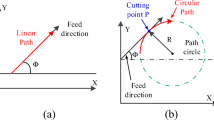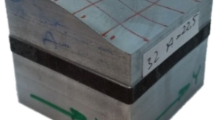Abstract
Four tool path strategies such as equal-interval tool paths, parallel tool paths, parallel–tangency tool paths, and freeform tool paths are proposed in computer numerical control milling of a complex freeform surface. The objective is to understand how 3D tool paths influence their machining efficiency, surface quality, and form accuracy. In this study, their scallop heights were less than or equal to 15 μm. First, their scallop heights distributions and 3D tool path distances were theoretically analyzed; then, four tool path strategies were investigated with reference to machining efficiency, surface texture height, surface roughness, and form errors. It is shown that scallop heights distribution can be used to display the surface texture state and predict tool path distance. Experimental results indicate that the surface texture height, the surface roughness, and the form errors were nearly identical on the machined flat location and surface for various tool path strategies, whereas their surface quality and form accuracy are easily destroyed on the abrupt ones except for the parallel tool paths. Although the freeform tool paths produce the shortest tool path distance through 3-axes driving mode, the parallel tool paths offer the best surface quality and form accuracy through 2-axes driving mode. This is because the 3-axes driving and its vector changes on abrupt location easily lead to large machine vibration and movement errors. It is confirmed that the parallel tool path strategy with 2-axes driving mode can improve the surface quality and form accuracy in actual milling of a complex freeform surface.
Similar content being viewed by others
References
Sun YW, Guo DM, Jia ZY, Wang HX (2006) Iso-parametric tool path generation from triangular meshes for freeform surface machining. Int J Adv Manuf Tech 28:721–726
Yoon JH (2007) Two-dimensional representation of machining geometry and tool path generation for ball-end milling of sculptured surfaces. Int J Prod Res 45:3151–3164
Tournier C, Duc E (2005) Iso-scallop tool path generation in 5-axis milling. Int J Adv Manuf Technol 25(9–10):867–875
Kim SJ, Yang MY (2006) A CL surface deformation approach for constant scallop height tool path generation from triangular mesh. Int J Adv Manuf Technol 28:314–320
Lu Y, Xu J (2007) Computer simulation machining a 3D free surface by using a 3-RPRU parallel machine tool. Int J Adv Manuf Technol 33:782–792
Ramaswami H, Shaw RS, Anand S (2011) Selection of optimal set of cutting tools for machining of polygonal pockets with islands. Int J Adv Manuf Technol 53:963–977
Xie J, Zhou RM, Zhang XF (2010) Study on discrete form algorithm of cutter location surface in CNC milling of freeform surface. Int J Adv Manuf Technol 49(1–4):195–200
Rangarajan A, Dornfeld D (2004) Efficient tool paths and part orientation for face milling. CIRP Annals-Manu Tech 53(1):73–76
Lazoglu I, Manav C, Murtezaoglu Y (2009) Tool path optimization for free form surface machining. CIRP Annals-Manu Tech 58:101–104
Jung TS, Yang MY, Lee KJ (2008) A new approach to analysing machined surfaces by ball-end milling, part II: roughness prediction and experimental verification. J Mater Process Technol 204:94–102
Xie J, Zou MS, Cui XL (2009) Effect of curvature distribution feature of complex freeform surface on cnc milling performance. J Mech Eng 45(11):158–162
Korosec M, Kopac J (2008) Improved surface roughness as a result of freeform surface machining using self-organized neural network. J Mater Proc Tech 20:494–102
Lacalle LN, Lamikiz A, Sa’nchez JA, Salgado MA (2007) Toolpath selection based on the minimum deflection cutting forces in the programming of complex surfaces milling. Int J Mach Tools Manufac 47(2):388–400
Xie J, Zhou RM, Xu J, Zhong YG (2010) Form-truing error compensation of diamond grinding wheel in CNC envelope grinding of freeform surface. Int J Adv Manuf Tech 48(9–12):905–912
Author information
Authors and Affiliations
Corresponding author
Rights and permissions
About this article
Cite this article
Zhang, X.F., Xie, J., Xie, H.F. et al. Experimental investigation on various tool path strategies influencing surface quality and form accuracy of CNC milled complex freeform surface. Int J Adv Manuf Technol 59, 647–654 (2012). https://doi.org/10.1007/s00170-011-3515-z
Received:
Accepted:
Published:
Issue Date:
DOI: https://doi.org/10.1007/s00170-011-3515-z




